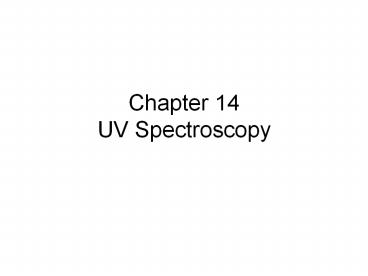Chapter 14 UV Spectroscopy - PowerPoint PPT Presentation
Title:
Chapter 14 UV Spectroscopy
Description:
Chapter 14 UV Spectroscopy ... compounds can absorb light in the ultraviolet region of the spectrum The electrons in the highest occupied molecular orbital ... – PowerPoint PPT presentation
Number of Views:175
Avg rating:3.0/5.0
Title: Chapter 14 UV Spectroscopy
1
Chapter 14 UV Spectroscopy
2
Conjugated and Nonconjugated Dienes
- Compounds can have more than one double or triple
bond - If they are separated by only one single bond
they are conjugated and their orbitals interact - The conjugated diene 1,3-butadiene has properties
that are very different from those of the
nonconjugated diene, 1,5-pentadiene
3
14.8 Structure Determination in Conjugated
Systems UV Spectroscopy
- Conjugated compounds can absorb light in the
ultraviolet region of the spectrum - The electrons in the highest occupied molecular
orbital (HOMO) undergo a transition to the lowest
unoccupied molecular orbital (LUMO) - The region from 2 x 10-7m to 4 x 10-7m (200 to
400 nm) is most useful in organic chemistry - A plot of absorbance (log of the ratio of the
intensity of light in over light transmitted)
against wavelength in this region is an
ultraviolet spectrum see Figure 14-12
4
14.9 Ultraviolet Spectrum of 1,3-Butadiene
- Example 1,4-butadiene has four ? molecular
orbitals with the lowest two occupied - Electronic transition is from HOMO to LUMO at 217
nm (peak is broad because of combination with
stretching, bending)
5
(No Transcript)
6
14.10 Interpreting UV Spectra Effect of
Conjugation
- ?max wavelength where UV absorbance for a
compound is greatest - Energy difference between HOMO and LUMO decreases
as the extent of conjugation increases - ?max increases as conjugation increases (lower
energy) - 1,3-butadiene 217 nm, 1,3,5-hexatriene 258 nm
- Substituents on ? system increase ?max
- See Table 14-2 for examples
7
(No Transcript)
8
14.11 Conjugation, Color and the Chemistry of
Vision
- Visible region is about 400 to 800 nm
- Extended systems of conjugation absorb in visible
region - b-Carotene, 11 double bonds in conjugation, ?max
455 nm - Visual pigments are responsible for absorbing
light in eye and triggering nerves to send signal
to brain

